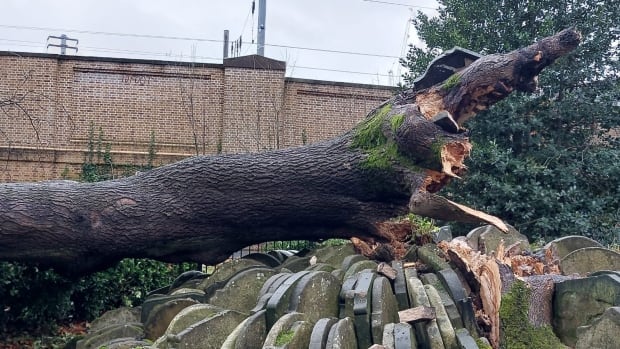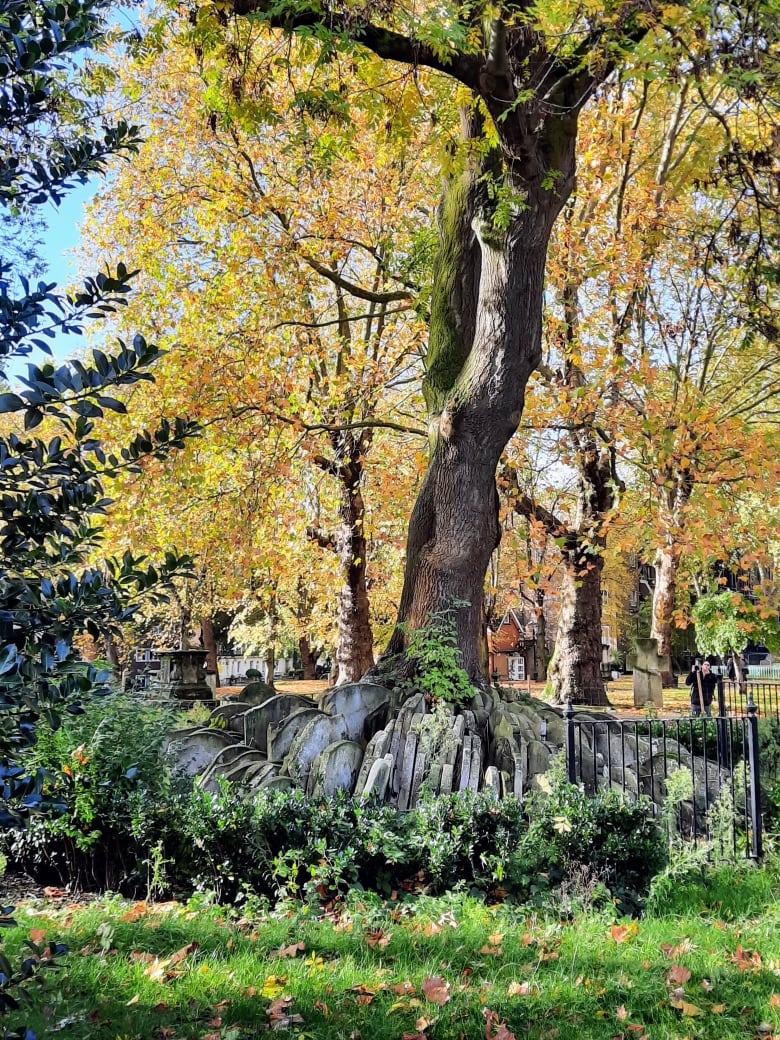
As It Happens7:08After 150 years of life surrounded by gravestones, London’s Hardy Tree falls
London, U.K., tour guide Jack Chesher has walked many people through the history of the Hardy Tree. Named after the Victorian-era writer Thomas Hardy, the lone ash tree is just a short walk from King’s Cross station, in St. Pancras Gardens, surrounded by gravestones.
It has been celebrated as a symbol of life amid death for over 150 years, but now the famous tree has met its own end. The Hardy Tree toppled over this week, after being weakened by a recent storm.
“My immediate reaction was sadness, really,” Chesher told As It Happens guest host Helen Mann. “It’s a beautiful thing to look at.”
He described the roots of the tree, growing in between the gravestones, as a powerful image, even though he knew it was dying.
The Hardy Tree was infected with a fungus in 2014, and since then the infection has been rotting the tree from the inside. The local Camden Council, expecting the tree’s death, took steps to manage its final years.

“There’s a railing around the tree,” Chesher said. “You used to be able to get up close to it, but [now] for a little while they had a railing all the way around the tree so that if it did fall, it wouldn’t fall onto someone.”
Chesher noted there were plans to replace the railing with a larger and “a bit nicer looking” structure, but a series of storms this year made the tree weaker. Then, after all these years, the tree finally fell earlier this week.
“At about 2:30 p.m. on Boxing Day, some locals heard it crash to the ground,” he said.
The tour guide visited St. Pancras Gardens on Wednesday and saw a rose on one of the gravestones near the tree.
“Lots of people have been going and paying their respects,” he said. He also heard an impromptu reading of a Thomas Hardy poem.
The story of the Hardy Tree
Now, all that is left of the Hardy Tree is its trunk in a yard behind St. Pancras Old Church. The church yard was once used for burials — and was much bigger than it is now.
That was until the 1860s, when plans for a railway line cut through the yard, and in order to build the station, something had to be done about the approximately 10,000 bodies buried there.
Thomas Hardy was an architect’s apprentice at that time. Chesher said that he had the “horrific” and “gruesome” job of exhuming those bodies and moving their gravestones.
“You’d have thought it would be an artist or a writer or someone with a vivid imagination that would put together this display of gravestones,” he said. “I think … [it] is said to have affected him quite a lot actually.”

Chesher says that pile of perfectly stacked gravestones gathered around the ash tree reminds him of contrasts, such as life and death, the uplifting and the macabre, and the destructive and the beautiful. And Chesher says you can see those themes in Thomas Hardy’s writing.
“Living through that Victorian period, sometimes called the age of destruction — because of the railways, because of the huge clearance schemes that were happening in London at the time — so much was having to be knocked down in the name of progress,” said Chesher.
“The Hardy tree is very much a product of that period.”

The circle of life
Camden councillor Adam Harrison put out a statement yesterday about the plans for the fallen tree.
“We were very sorry to see that the much-loved Hardy Tree has come down and we have already started the discussion with members of the local community about ways to commemorate the tree and its story,” the councillor said.
The council is considering harvesting the wood to create a commemorative object, such as a bench, or planting a new tree. Chesher, on the other hand, brought up the idea of letting nature take its course.
“I spoke to the rector actually, and he would just quite like it to stay there as it is … as it decomposes…. That would also be part of its story,” the tour guide said.